

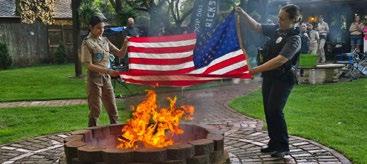
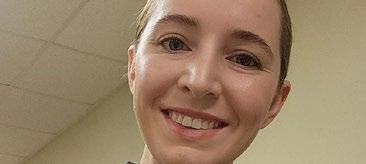









BY MARLYS CERVANTES
“May we think of freedom, not as the right to do as we please, but as the opportunity to do what is right.” ~Peter Marshall, Scottish-American Pastor
As we celebrate the 4th of July, we see U.S. flags all around us, and it seems a good time to consider a few things about the upkeep of the flags themselves. At First United Methodist Church in Ponca City, we host Troop 501 of the Boy Scouts of America, which is a troop comprised of young women instead of young men. These young women serve the church and community in a variety of ways.
One way that comes to mind this time of year deals with a flag ceremony. When I asked about the process for retirement of flags, I was told that they generally do so along with their Court of Honor, to make it an even more formal event.
Members of the church or community leave worn flags for the troop in our church office. I know I have friends who give me their worn flags to bring along with ours for proper disposal. As a church, we’ve made this service more well-known recently so others in the community who do not personally know another Scout member or organization that provides the service will have a place to bring their flags.
The most recent Court of Honor
was held at Scout Master John King’s house with 11 scouts, five leaders, and several family members and guests, including two Ponca City police officers, present. The Court of Honor had several highlights.
Senior Patrol Leader
Lily Davenport opened the Court of Honor with the presentation of colors followed by the Pledge of Allegiance, Scout Oath, Scout Law and the Outdoor Code. Next Davenport, assisted by Quartermaster Caitlin Cannon, presented the Scouts with multiple merit badges they had earned.

Alyssa Cannon was introduced as the troop’s newest Eagle Scout, and Lauren King was recognized as having achieved the rank of Life Scout. Cannon, Davenport and Phoenix Castro were recognized as having achieved the rank of Star Scout.
After all eligible scouts received their badges, the special flag retirement ceremony began. According to the U.S. Flag Code, your flag, no matter how worn or tattered cannot just be thrown away. It must be “destroyed in a dignified way, preferably by burning.”
For most people, giving their flags to a Scout troop or an organization such as the American Legion or Veterans of Foreign Wars is the best solution. Troop 501 had over a dozen
U.S. flags and two Oklahoma flags to give a final parade and presentation before placing them into the fire. Each flag is paraded past the group present, unfurled to its full size for a final moment commemorating its last time representing our nation (or the state in the case of the Oklahoma flags) before it is placed in the fire. Those present then watch the smoke curl its way upward to the heavens.
“A lot of things go through your head as you watch this final viewing of each flag,” says Scout Leader Tamara Bucher. “Ultimately, I thought most about the privilege that our troop has in being asked to retire these symbols of our country. The Scouts’ demeanor as they carried the flags showed that they knew they were entrusted to retire these American symbols with the

utmost respect and reverence, and they did so.”
The last bit of the ceremony this time included the burning of a worn Bible of Laura Southard, a member of partner church First Presbyterian, which had a tattered cover and pages falling out. The Bible was given back to the Lord through the flames, where it was recognized that the Word within never changes even though the physical nature of the book became worn. The pages created different colored smoke that rose, turning then to ash.
It would seem the scouts have Pastor Peter Marshall’s attitudes about service just right—they look toward our nation as a place of freedom and respect, but they do so with thoughts of service and ethics. The young women of Troop 501 are truly role models for others in the community, and
even those of us much older than they can learn from their willingness to serve and their diligence in earning merits and rank along with respect.
“The ceremony was moving,” says Bucher, “and created a great deal of thoughtful conversation afterward.” The leaders and scouts of Troop 501 would like to thank host church First United Methodist Church and now partner church First Presbyterian Church for their ongoing support.


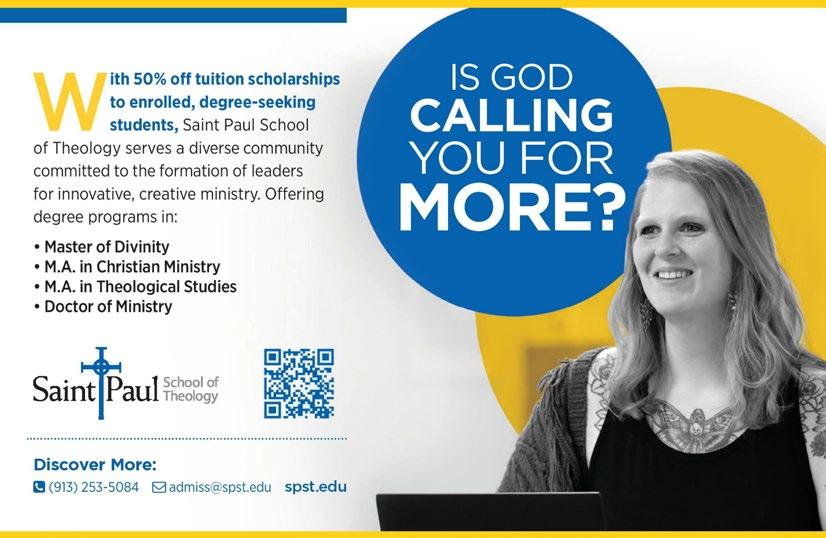
BY REV. MICHAELA DRAIN
Trigger warning: This article looks at the topic of suicide in youth and young adults.
The song that has been blasting through my speakers all summer is “The Spark” by Kabin Crew. Besides it being a fun song with a good beat, the lyrics are what keep me singing along at the top of my lungs. Somehow this group of middle schoolers from Cork, Ireland summarized the reason why I do what I do in my ministry with youth and young adults. If you haven’t heard the song, the chorus goes:
“Think you can stop what we do? I doubt it. We’ve got the energy, we’ll tell you all about it. I searched for my spark and I found it. Everybody in the club starts bouncing.”
On the surface, these words do seem rather simple and not related to faith at all. I admit that it is silly and an oversimplification of my ministry but there is scientific proof to back my new summer mantra. If you work anywhere within youth and young adult ministry, you have seen a rise in the number of people in mental and emotional crisis in the past few years. Psychologists have noted a


considerable spike in counseling since 2020, even at prestigious universities. Places where students are supposed to be the top performers in the nation. Students at these prestigious schools are struggling with mental, emotional, and physical strains that impede their abilities. Often these struggles lead many youth and young adults to consider extreme solutions to end the pain. They turn to solutions like delusion, drugs, alcohol, adrenaline-seeking, and even suicide. This is usually when they pay a visit to the chaplain. Slightly due to name association, they come to me when they are mentally, physically, and spiritually drained of life. In counseling sessions, I find that this visit is not their first stop. People seek faith for healing internal turmoil as a
last resort.
Dr. Lisa Miller, a psychoanalyst who studies the impact of spirituality on the brain, says that a life of faith should be high on the list for healing psychological crisis. In her study of the brain development of youth after experiencing trauma, she found that the quickest way to predict a child’s resiliency is to see if they have a personal faith. I have included an infographic on all her statistics so that you can see the massive difference made by a life of faith. To put these numbers in perspective, the FDA only needs a 10 percent proven viability rate to approve treatments and medication for public use. Spirituality goes way above and beyond the FDAs requirement. Spirituality is so beneficial because having a life of faith gives you a purpose and a built-in support system to live out that purpose.
This is where the kids from Cork got their lyrics right on point. When you find your “spark,” it gives you the energy to thrive in life no matter the circumstances. People who have a purpose (or a spark) are so full of life that they cannot be stopped. They may be slowed down by things like trauma, depression, and life disruptions but they will keep pushing toward that purpose in everything that they do.
Dr. Miller’s study found that the best preventative barrier for people in mental crisis is when mental health professionals work alongside the
person to develop a spiritual core. She states that a strong spiritual core stops further deterioration of the brain and encourages post-traumatic growth. To use the terminology of Gen Z and Gen Alpha, “hallelu-lu is the solulu.”
So all that to say, I think that song plays on repeat in my mind because I help people find their spark in the Holy Spirit. Whenever a person comes to me for pastoral care, it is because they are living life without their spark. They don’t know who they are, what they are supposed to do, or where they should go. My job as a chaplain is to counsel them as they find that thing that makes their heart strangely warm. This job is easy because we are already doing this at our churches. We don’t need any fun programs or new coffee shops. We already help people find their spark. We have so much spark that we fan it into a flame and put that flame on the signs in front of our church buildings.
Dr. Miller describes the steps to spiritual awareness development as “purpose, path, practices, and people.” We might not use those same words, but we already do these steps at our churches. We remind people that they have a purpose when we encourage them to share their spiritual gifts with the world. We connect people with their path when we talk about our beliefs in small groups on Wednesday nights and in worship on Sunday mornings. We have an overabundance of practices that give us the means of God’s grace from prayer, to confession, to Holy Communion, and so much more. And finally but most importantly, we surround them with people who love and support them in their call.
So maybe “The Spark” should be the summer mantra of the church. Because chaplains are not the only ones whose job is to help youth and young adults find their spark for life.

It is the job of the church as well. Hopefully this song helps you to remember that you need to share your spark of the Holy Spirit with others. God really is transforming the world from unending suffering to unending grace. And if you need more energy to tell the world all about, I have the perfect jam to get you hyped for the job.
If you or someone you know is experiencing suicidal thoughts or a crisis, please reach out immediately to the Suicide Prevention Lifeline at 800-2738255 or text HOME to the Crisis Text Line at 741741. Or call the 988 Lifeline. These services are free and confidential.
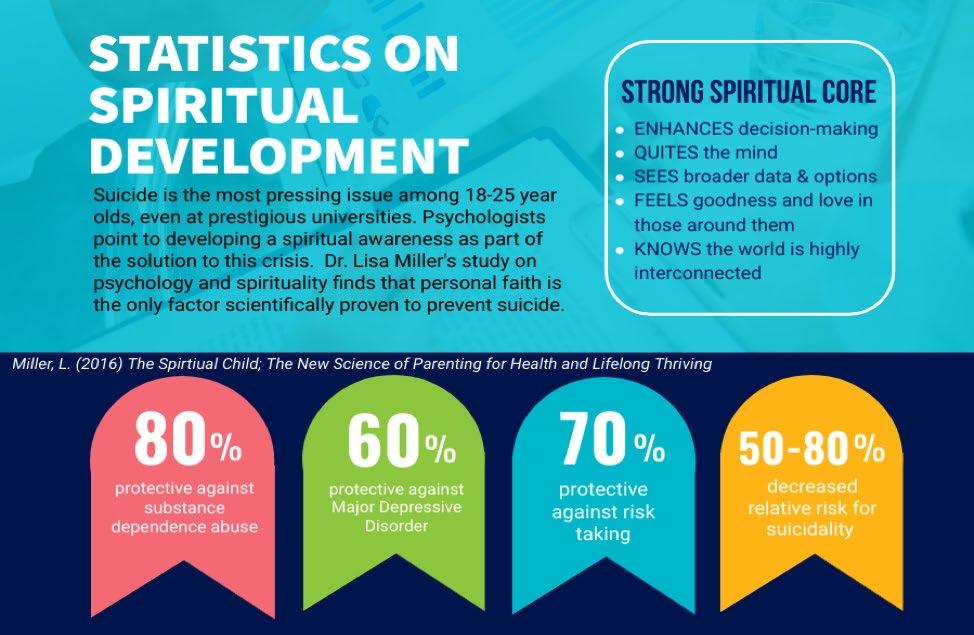

We had a conversation with Conference Archivist Christina Wolf, to find out what churches should do with old files, papers, and cool things they have on hand.
What should churches do with interesting historic finds? I’m specifically thinking of historic items that aren’t official records, but those cool, interesting things found in the back of a cabinet. A few years ago, I found 1950s hand-written committee meeting minutes that gave the names of the women as Mrs. Husband Lastname, and told which foods they brought. It was all done in pencil. There’s no legal reason to keep those, but it’s the most interesting stuff in the building.
Those older minutes are very interesting and represent a snapshot of not just the local church but of contemporaneous societal norms. Indeed, committee minutes are official records and considered archival and should be kept in the local church archives. Minutes often document the people, decisions, and events that make up the ministry of the church.
If a church finds old and interesting treasures, are they something you would want to take in?
if the membership deems the item to be of historical significance or if the item falls within the guidelines for archival purposes. We do occasionally take in some vital records from an active local church if there are space or preservation concerns.
Q A Q A Q A Q A
Not necessarily. Items like that should be kept in the local church archives
There are guidelines for the local church on what they should be saving in their local church archives. I have retention schedules that I can share with individual churches (I’m working on updating these - the guidelines are posted on the okumc website at Archives and History Tools (okumc. org).
Are there specifications for what people might be able to submit to A&H?
From the active local church, we would like copies of published church histories (these can be a few pages to a commercially published book). Sometimes a local church will find materials that may not pertain to their local church but have some Conference-wide significance. If in doubt, the local church can contact me.
What do people typically reach out to A&H for? Do people do research using your archives? What are the most interesting things you have there?
The Archives and Special Collections at Oklahoma City University includes the University Archives, the
Oklahoma United Methodist Church Archives, and Special Collections. The Oklahoma Annual Conference archives are one piece (a very large one!) within the Oklahoma United Methodist Church Archives.
We are the repository for the Oklahoma Indian Missionary Conference as well. Our records include predecessor conferences and denominations going back to the mid-1800s. Researchers can find information about the Methodist Episcopal Church (pre-1844); the Methodist Episcopal Church (North); the Methodist Episcopal Church, South; the Evangelical Association; the United Brethren in Christ; the Evangelical United Brethren; The Methodist Church; and The United Methodist Church. We also have journals, church records, Conference board, committee, and district records for those conferences that include Oklahoma within those denominations.
We do get calls from people needing baptism and membership records, statistical information, genealogical requests, graduate students researching aspects of religion and Methodism, and photographs of ministers (we have very few, so if a local church has portraits of ministers that have served, we would love copies!). The bulk of our records come from the District Offices and Ministry Center and include charge conference reports, committee and board minutes, closed church records, and the like. We routinely archive the Contact and Say So magazine (digital and print
editions).
People are welcome to come to the Archives Reading Room (fifth floor of the Dulaney-Browne Library in room 508) to conduct research. We have had professional historians, graduate and undergraduate students (both OCU and other institutions), individuals researching their genealogy, group members getting ready for an anniversary (for instance United Methodist Women have done some research in the archives). Church historians and local church archivists and history committees have also reached out for advice on what to keep in their archives and how to write a church history or how to plan for a celebration/anniversary.

AQCan I come visit the archives?
Please do! You can make an appointment with me here.
If you have old photos you’d like to get copies of, we have some advice.
Use the best quality camera available. This can definitely include a smartphone! Smartphones have excellent cameras these days.
Remove the photo from any glass or protective covering. Those surfaces are reflective and will not photograph well. Ensure there is plenty of light, but make sure it’s not harsh. If photos are glossy, they could reflect light.
Photograph at an angle. Though this is not always necessary, taking a picture from a bit to the side can help reduce reflections on the photo.
If your church has a wall, album, or other display of previous clergy, Archives and History would like copies! Reach out to Archivist Christina Wolf at cwolf@okcu.edu for more information.

from Carol McDonald, DA for Central District
“I make this for every potluck and it always disappears! The name of the salad is technically Orange Jello Salad; however, my dad loved this stuff so much we call it “Daddy’s Salad.”
Orange Jell-o Salad (Daddy’s Salad)
1 large box orange Jell-o - do not mix according to directions
1 large container cool whip
1 large container of small curd cottage cheese
1 can mandarin oranges
1 can crushed pineapple
from Wanda Clark, Administrative Coordinator for Camps and Retreat Ministries
“One of Caleb’s and my favorite things to make is Snoop Dogg’s mac and cheese from his cookbook, From Crook to Cook: Platinum Recipes from Tha Boss Dogg’s Kitchen.”
Snoop Dogg’s Mack and Cheese
2 tsp salt, plus more for salting the water
1 lb elbow macaroni
2 cups whole milk
1 cup heavy cream
4 Tbsp unsalted butter
1/4 cup all-purpose flour
5 cups shredded extra-sharp Cheddar cheese
4 Tbsp unsalted butter
1/4 cup all-purpose flour
2/3 cup sour cream
1 tsp cracked black pepper
2 tsp dry mustard
1/2 tsp ground nutmeg
2 tsp Worcestershire sauce
1/4 tsp cayenne pepper
1. Preheat the oven to 400°F [200 C]. with a rack in the middle position, Lightly butter a 9-by-13-in [23-by-33-cm]
Strain the liquid from the mandarin oranges and the crushed pineapple. In a large bowl dump the large carton of cottage cheese and the dry orange Jell-o mix. Dump the drained fruit into the now orange cottage cheese mixture and fold it in. Fold in the entire container of cool whip. Refrigerate for a couple of hours to let the flavors meld together and enjoy!
The lovely thing about this is you can substitute the flavor of Jell-o or which fruits you want!
baking dish and set aside.
2. Bring a large pot of heavily salted water to a boil. Add the macaroni and cook until al dente, about 1 minute less than the package instructions. Drain and set aside.
3. In a small saucepan over medium heat, heat the milk and cream, being careful not to boil it.
4. While the milk heats, in a large skillet over medium heat, melt the butter. Sprinkle in the flour and whisk constantly for 2 to 3 minutes. Gradually whisk in the warmed milk. Cook for 2 minutes, whisking frequently, or until thickened and smooth. (Adjust the heat to keep the milk from boiling)
5. Gradually add 2 1/2 cups [200 g] of the shredded cheese, whisking until fully incorporated and smooth. Add the sour cream and whisk until smooth. Add the pepper, dry mustard, cayenne, and Worcestershire sauce, Season with salt.
6. Add the cooked macaroni to the cheese sauce and stir until combined. Spoon the mixture into the prepared baking dish. Top evenly with the remaining 2 1/2 cups [200 g] of cheese. Bake for 25 to 30 minutes, or until golden and bubbly. Serve warm
7. If you’re not serving it the same day, the Mack and Cheese can be kept, covered in the refrigerator, for up to 3 days, or in plastic wrap and aluminum foil in the freezer for up to 2 months.
from Jena Barber, Editor of Publications for Communications
“All of the amounts in this recipe are guesstimates, based on years of making this recipe. We never have to bother with leftovers! But be sure to keep this salad in the fridge until time to serve.”
No Leftovers Potato Salad
1 bag frozen homestyle hashbrowns (not shredded)
1/2 red onion
1/2 red bell pepper
1/2 yellow bell pepper
2 ribs celery
1 lb bacon, cooked
4 eggs, hard boiled, peeled
1/2 cup mayonnaise
1/2 cup sour cream
1 tsp white vinegar
1 tsp lemon juice
Salt & pepper to taste
Preheat oven to 375 degrees (this can be done early in the morning so it won’t heat the house as badly). Spray two cookie sheets with cooking oil. Spread the hasbrowns out; cook for approx. 15 min. or until cooked through. Set the hashbrowns out to cool.
Dice red onion, bell peppers, and celery. Transfer to a large mixing bowl. Add cooled hashbrowns and gently mix. In a small mixing bowl, combine mayo, sour cream, vinegar, lemon juice, and salt and pepper. Fold into potato mixture.
Cut cooled, cooked bacon and dice eggs. Gently fold the entire mixture together. If you like hot stuff, add 1/4 cup diced jalapenos (or more or less, depending on your taste).
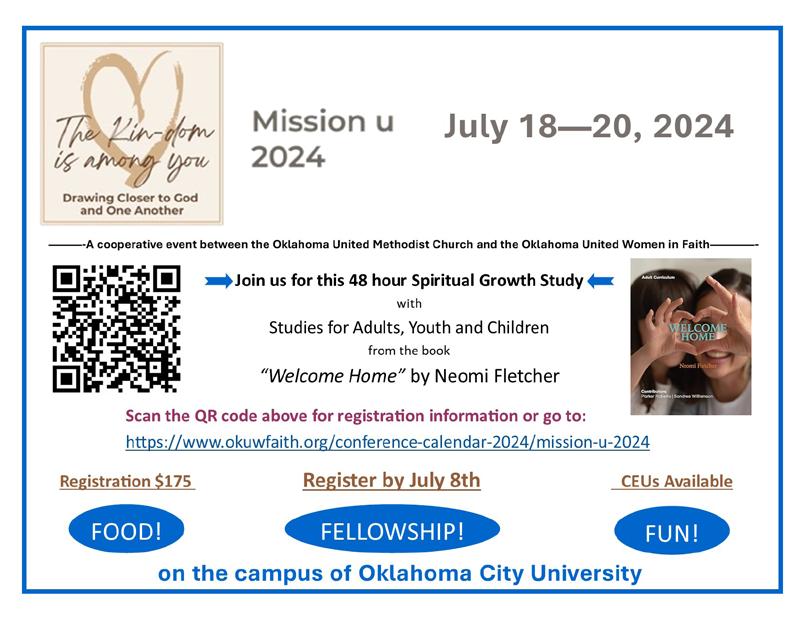


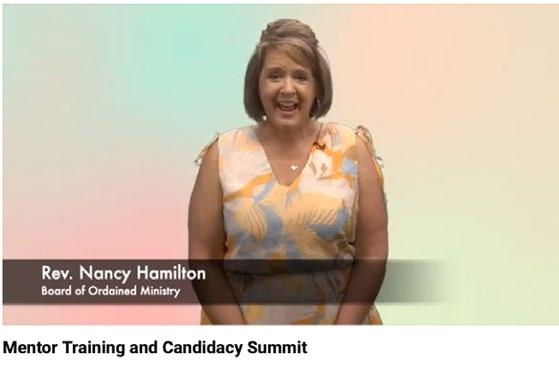
PRESS PLAY: Click on the picture to learn more about upcoming opportunities.
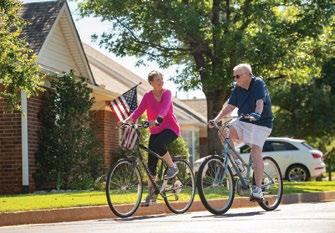
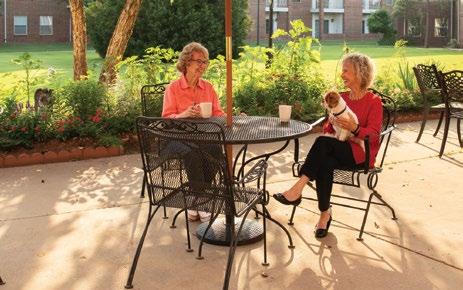
Life at Epworth Villa is all about freedom. Freedom from home maintenance and chores. Freedom from having to drive all over town. Freedom from worrying about future needs. And when you’re free to live your best life, it’s amazing the joy that each day brings. Experience the freedom you deserve and check out our spacious cottages and beautiful apartments at EpworthVilla.org.
The 2024 mentor training will take place on August 1, 2024, from 1 p.m. – 5 p.m. at the Oklahoma Methodist Ministry Center located at 1501 N.W. 24th St. Oklahoma City, OK 73106. This training is for candidacy, provisional and local pastor mentors. You can register here.
The 2024 Candidacy Summit will take place on August 2-3, 2024, at the Oklahoma Methodist Ministry Center located at 1501 N.W. 24th St. Oklahoma City, OK 73106. This training is for declared candidates, certified candidates and provisional members. You can register here.
Find out more about both of these from the video on page 11.
Share your event or job opportunity in the Contact For consideration, email your listing to editor@okumc.org.